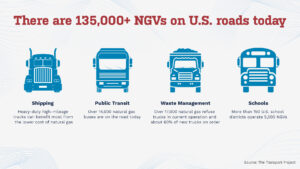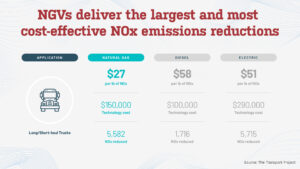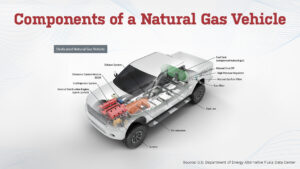Natural gas…vehicles?
We talk a lot here about the advantages of natural gas for electricity generation, home heating and powering appliances in our homes like clothes dryers and kitchen stoves. But, one of the area with the most potential to grow the affordable, reliable and clean advantages of natural gas is transportation.
Most people don’t realize that there are already thousands—more than 135,000 to be exact—natural gas vehicles (NGVs) on U.S. roads today. And, there are more than 23 million NGVs in use worldwide. According to the U.S Department Of Energy’s Alternative Fuels Data Center, “The advantages of natural gas as a transportation fuel include its domestic availability, widespread distribution infrastructure, and reduced greenhouse gas emissions over conventional gasoline and diesel fuels.”

Many of these vehicles are part of government and private fleets, with natural gas powering vehicles like buses and garbage trucks. Just a few examples of organizations that have already embraced NGVs:
- In 2023, Walmart debuted five new tractor trailers with compressed natural gas (CNG) engines built by Cummins.
- In 2020, UPS announced it would purchase more than 6,000 natural gas-powered trucks. A year later, they took even greater advantage of the clean and affordable NGVs by committing to buy 250 million gallons of renewable natural gas (RNG) to power their NGVs.
- Waste Management has spent at least $2.5 billion building a CNG fleet and another $300 million to build fueling stations around the county. The company even runs some of its trucks on RNG collected from its own landfills.
- Dallas-Fort Worth International Airport became North America’s first carbon neutral airport by converting 95% of its fleet—shuttles, trucks, sedans and other equipment vehicles—to natural gas.
The advantages are the greatest for long-haul trucks that can benefit from the lower cost of natural gas to travel their extensive shipping routes.
The real clean and green.
As the Dallas-Fort Worth International Airport success story shows, if you truly want to go green and clean, natural gas is the answer. Natural gas is already the reason that the U.S. is a world leader in lowering emissions. Increased use of natural gas for electricity generation is the top reason for U.S. power sector emissions reductions over the past 17 years—almost double the impact compared to renewable power generation. With NGVs, we could achieve the same victory in the transportation sector.
In the U.S., transportation is the largest contributor to greenhouse gas (GHG) emissions accounting for 28% of the emission produced in 2022. And, 23% of those emissions came from medium- and heavy-duty trucks. But, NGVs cut those emissions exponentially compared to gasoline, diesel and even electric vehicles (when you take into account their full life-cycle of emissions).
According to the U.S Department Of Energy’s Alternative Fuels Data Center, “The U.S. Environmental Protection Agency (EPA) requires all fuels and vehicle types to meet increasingly lower, near zero, thresholds for tailpipe emissions of air pollutants and particulate matter. One advantage to natural gas vehicles (NGVs) is their ability to meet these stringent standards with less complicated emissions controls.” Take the pollutant nitrogen oxide (Nox) as an example. According to The Transport Project, a group that advocates for more NGV use, NGVs provide the largest and most cost-effective reduction of NOx emissions. “The newest natural gas engines with Near-Zero – or Zero Emissions Equivalent – technology exceed stringent new federal NOx emissions standards.”

We can do better than EVs.
The climate hysteria crowd would have you believe the only environmentally-friendly transportation technology out there is electric. But, much like the failed solar installations that were supposed to revolutionize our electrical grid or supposed climate-destroying effects of importing LNG that weren’t (see our last ATEA for more on that), EVs increasingly seem to be a green pipe dream.
Electric vehicle prices remain out-of-reach for many American families and individuals. The average price of an EV in March was $59,205—nearly $12,000 more than their gas-powered counterparts. And, despite years of promises and government subsidies, the EV charging infrastructure still just isn’t there to make electric practical for drivers around most of the United States. On the commercial side, as The Transport Project puts it: “As battery electric heavy-duty trucks come to market, their per unit cost is often double the natural gas alternative…too prohibitive for most end users. Even more, the cost to build out needed on-site fast charging infrastructure makes full scale battery electric vehicle deployment financially out of reach for most commercial fleets.”

The transition from gasoline-powered vehicles to NGVs is potentially much simpler and more appealing to consumer than the failed push toward EVs. NGVs use many of the parts as those in a traditional gasoline-powered car. Horsepower, acceleration, and cruise speed in an NGV are all comparable to traditional vehicles. In fact, conversion of gasoline-powered vehicles to NGVs is already an option. If we truly wanted to make our American transportation system not only clean but also practically affordable for everyday Americans, a look at mass-production of passenger NGVs would be more realistic than EVs.
According to the U.S Department Of Energy’s Alternative Fuels Data Center, “The upfront costs to convert fleet vehicles to natural gas can be offset by lower operating and maintenance costs over the lifespan of the vehicles. The payback period depends on the fleet’s average distance traveled, required fueling infrastructure costs, and other considerations.”’ Those same cost-savings could be applied to regular passenger cars and trucks.
Build, baby, build, but make it transportation.
At TEA, we’ve been preaching the “build, baby, build” mantra for some time now. And, yes, we usually mean energy infrastructure like pipelines, refineries and transmission lines. But, we can also apply the “build, baby, build” principles to the way Americans move around our great nation. At a time when we are focusing on reshoring American manufacturing, NGVs offer an obvious opportunity that’s already been tested and tried by some of our toughest vehicles. Unlike what we’ve seen with the failed transition to electric vehicles, we could easily develop and build NGVs for America’s drivers in the same plants where we build gasoline-vehicles, without the headaches of training workers on new skills and acquiring resources from unfriendly trading partners like China.
The American auto industry was one of the manufacturing victories that built this great nation into the powerhouse we are today. Rather than letting that victory dwindle, a transition to NGVs could be the change the industry needs to get back to its roots while also providing Americans with the affordable, reliable and clean transportation choice of the future.
https://empoweringamerica.org/gas-up-emissions-down-the-future-of-transportation/
No comments:
Post a Comment
Note: Only a member of this blog may post a comment.